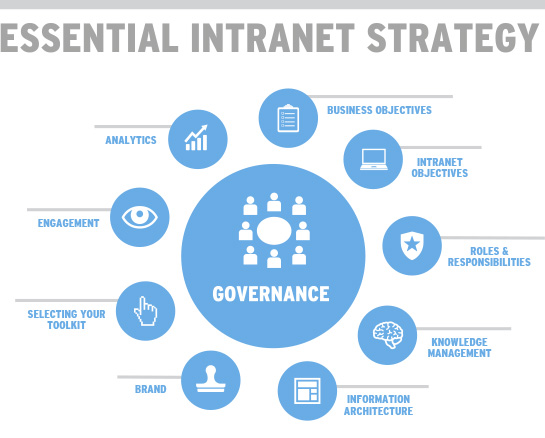Are you steering your intranet in the right direction?
At Interact we like to think we know a lot about what makes an intranet successful. Having worked with hundreds of customers across the world on intranet design, installs, launches and reviews, we have now pooled together our knowledge and as a result have formulated our Essential Intranet Strategy (EIS). The Essential Intranet Strategy is designed to ensure every customer achieves success with their intranet from the very beginning.
We’ve identified ten elements that when effectively managed, we believe can contribute to an effective and essential intranet.

On 20th March I will cover Interact’s EIS in more depth, in the webinar, ‘The Essential Intranet Strategy: 10 Key Elements to Intranet Success.’ For now I’m going to focus on the key element; Governance.
This both underpins all the other 9 elements whilst also supporting them. Governance touches upon all of the others and effective governance is dependent on the choices and decisions made within the other elements.
Governance is…
Simply, it is about steering your intranet in the right direction.
All too often we chat to intranet managers and intranet teams about governance and while they recognise the importance of it, they also appear to be wary of it. Nigel Williams, Interact’s Community Manager offers the following reassurance: “Governance should not stop people doing what they want to do; it should help them to do it better and more effectively.” The fear of governance may be fear of the unknown but if you break it down into its constituent parts, it’s a lot easier to understand and deal with.
Roles and Responsibilities
Have you identified who is needed in the intranet team? Have you defined and made them aware of what their responsibilities are and what commitment they need to make? This can be helped by defining “job specification” for each role.
User Management
How will users “appear” on the intranet? Will user account creation and management be controlled by active directory sync, or is there another process in place? What information will be featured as part of their core profile? Giving a user a profile with the ability to update it, is a key step in establishing that user’s presence on the intranet and within the community.
Permissions
What will users be allowed to do? How will their access and permissions be managed? More often than not, permissions and associated security groups will be linked to the structure of the intranet. Where possible a permissions strategy should be simple, with simplicity trumping complexity. Wherever possible try to minimise restrictions and have secure areas as the exception, not the rule.
Training
The different roles within the intranet and the likelihood that these roles will have different permissions mean that there is no “one fits all” to training. There will need to be different training activities and using different methods to allow for different learning styles. Yes, there will be some who will be adventurous and explore, but others will require a demo and the chance to experiment, there will also be some users who would welcome a user guide – online and paper versions. Don’t forget to have an eye on the future and to think about how new starts will be trained to. Does your intranet contain some content that will answer the question,”How do I use the intranet?”
Content Strategy
Content may be king, but those responsible for adding it need to be sure that they are adding the right content, in the right format. Wendy Jordan at Glasgow Housing Association encourages the GHA content editors to ensure that the content they add is “Used, Useful and Usable.” Content Strategy also needs to recognise that its not just about content addition, it’s about the on-going curation and when appropriate, deletion.
User Expectations
When engaging in “user” training there is a need to clearly state what the expectations are, for an end user it could be that this may be something like “You access the intranet on a regular basis so that you keep up-to-date with news and announcements and to complete tasks like expense claims and holiday booking”. For your content editors (and other identified roles) you may have a different, additional expectations. Recognise that “Expectation” is a two-way street though so the organisation needs to be aware of what user expectations are and address these when planning, designing launching, evaluating and evolving the intranet.
Analytics
Knowing at any point in time how the intranet is performing is an essential role of an intranet team. What are its strengths and weaknesses? Where is it performing well, where could improvements be made? How are the users – are they engaged with the intranet? Or are there groups whose adoption could be improved. Why are the non users not using it? You should be looking to regularly check the health of your intranet and make improvements on what you find.
Roadmap
An effective, essential intranet does not stand still; it will evolve as the needs of the business evolve and as the behaviour and expectations of the users change. Good governance will plan for regular reviews of intranet performance against objectives. It will make sure that the intranet is being used as required and if the business objectives change then it will ensure that the intranet changes to support these new aims.
